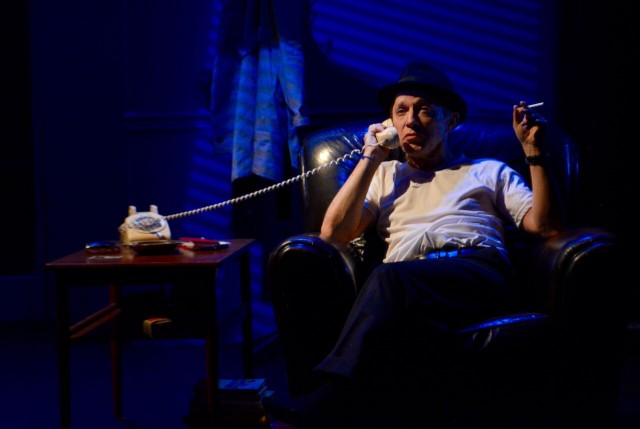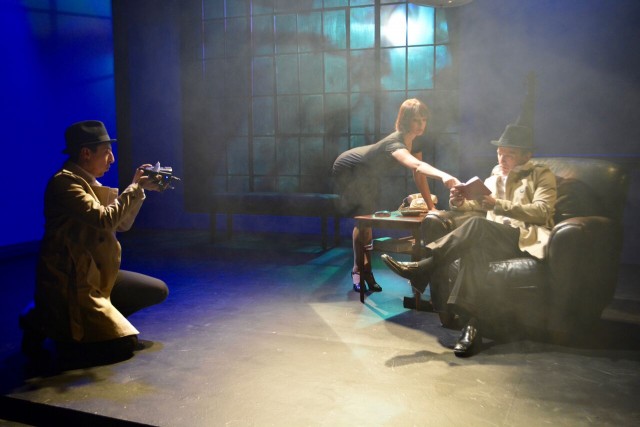
A phone call sets everything in motion in theatrical adaptation of Paul Auster’s CITY OF GLASS (photo by Arthur Cornelius)
New Ohio Theatre
154 Christopher St. between Greenwich & Washington Sts.
Wednesday – Sunday through March 12, $25-$30
888-596-1027
www.untitledtheater.com
www.newohiotheatre.org
Untitled Theater Company No. 61’s theatrical adaptation of Paul Auster’s debut novel, City of Glass, took on another layer of meaning on opening night last week when the original creator himself, the Newark-born, Brooklyn-based Auster, was in the audience, watching the show for the first time. “I have no idea what to expect,” he said on his way into the New Ohio Theatre. But those audience members familiar with the book knew to expect a literary puzzle, an investigation of identity, authorship, and communication on multiple, sometimes dizzying levels. The story, the first in Auster’s New York Trilogy (which also includes Ghosts and The Locked Room), involves a mystery novelist named Quinn who tries on the identity of private detective Paul Auster after receiving several phone calls looking for Auster. Quinn, who himself writes detective novels under the name William Wilson, featuring protagonist Max Work, gets caught up in a case in which a man who may or may not be named Peter Stillman was imprisoned for years by his father, also Peter Stillman, in their apartment. The younger Stillman is frightened now that the father is being released after a long stay in a mental institution. Adapter and director Edward Einhorn focuses on novelist Auster’s exploration of language, individual identity, and artistic and biological creation, interpreting the main characters — Quinn (Robert Honeywell), the younger Stillman (Mateo Moreno), and Stillman’s wife, Virginia (Dina Rose Rivera) — as well as the omniscient third-person narrator, as manifestations of Auster, making the writer a kind of father-god who built this existential world and looms over it (an especially vivid effect with Auster in the crowd that night). To further that concept, Honeywell speaks all of the words in the play, and the three actors are always dressed identically, as if the same person. (The noirish costumes are by Carla Gant.) When Honeywell speaks the other characters’ dialogue, Moreno and Rivera hover around him, sometimes mouthing words, moving like in an experimental dance. They also go behind a glass wall on which their faces are projected. “In the triad of selves that Quinn had become, Wilson served as a kind of ventriloquist, Quinn himself was the dummy, and Work was the animated voice that gave purpose to the enterprise,” the narrator explains early on, adding, “In effect, the writer and the detective are interchangeable.” These lofty ideas are treated with an intriguing existential subtlety in the book, but Einhorn brings them front and center in the play, losing the gentler aspects that made the short novel such a success.

Character and identity are interchangeable in CITY OF GLASS (photo by Arthur Cornelius)
Einhorn (Money Lab, The Velvet Oratorio) appears to be trying to make us uneasy from the very start. The chairs at the New Ohio are rather uncomfortable, leading to a lot of shifting and squirming. For parts of the show, the brightest of the lights from Gil Sperling’s rear projections shined directly into my eyes (but not my companion’s), making it hard for me to look at the stage. Moreno portrays Stillman Jr. with annoying spastic sounds and gestures that are severely off-putting, and Moreno’s and Rivera’s shadowing of Honeywell, choreographed by Patrice Miller, often gets confusing. On one side of Christopher Heilman’s set is a chair and telephone, on the other an outdoor pay phone, emphasizing those now-disappearing items of communication. Einhorn chooses to highlight certain elements of Auster’s novel, such as the scene in which Quinn meets Stillman Jr., at the expense of other critical turning points, such as when Quinn follows Stillman Sr. through the streets of New York City, resulting in a disconcerting, head-scratching imbalance. The noir atmosphere benefits from Freddi Price’s cool score, performed live on keyboards and guitar, but the general pacing of the show is far too bumpy. In a program note, Einhorn explains, “With every adaptation I create, I ultimately reconceive the context and make it about myself and my art. Who am I, and how does it relate to the play? Who are you, the audience?” Those questions are desperately in need of answers in this stilted production, particularly on a night when at least one member of the audience towered over it all.